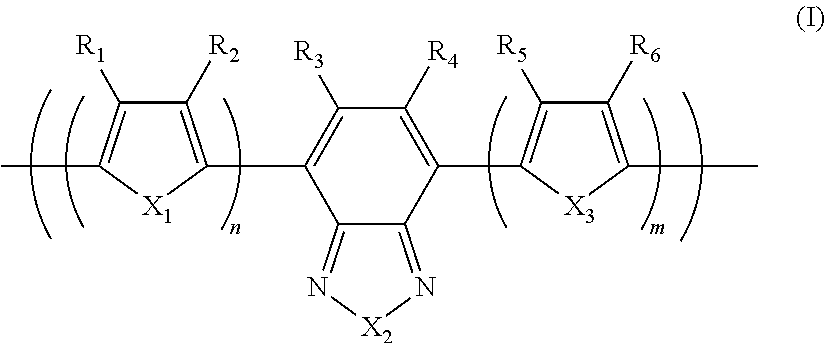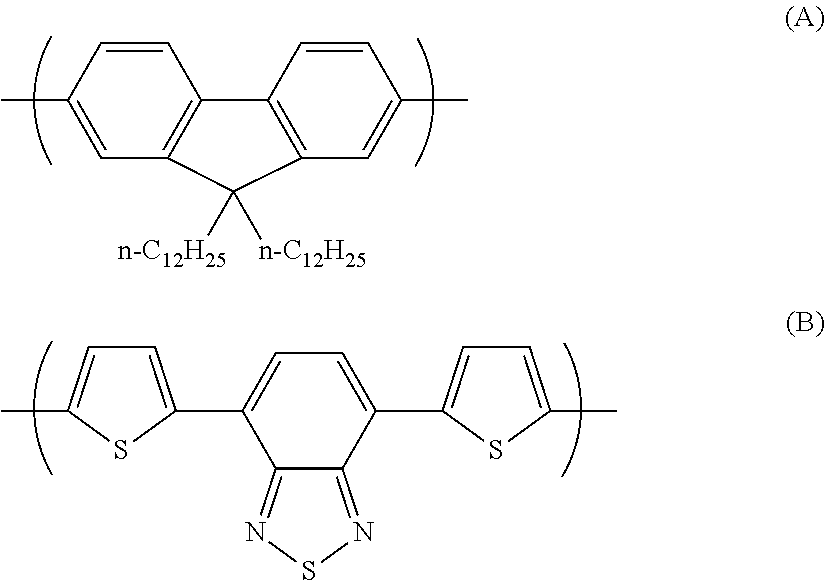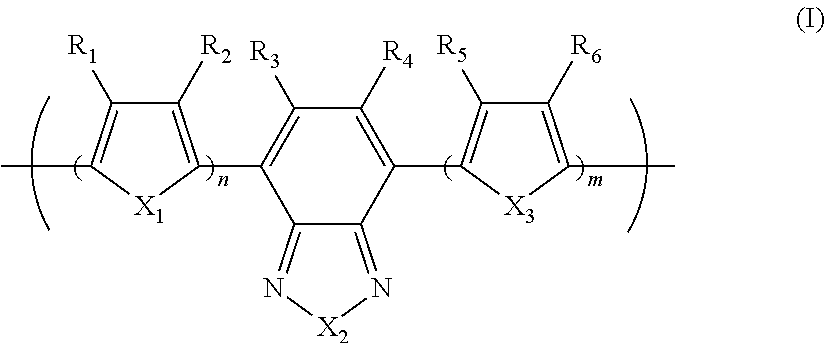Photoelectric conversion element
a conversion element and photoelectric technology, applied in the field of photoelectric conversion elements, can solve the problems of low photoelectric conversion efficiency of the above-mentioned organic thin film solar cell, and achieve the effects of improved photoelectric conversion efficiency, and high photoelectric conversion efficiency
- Summary
- Abstract
- Description
- Claims
- Application Information
AI Technical Summary
Benefits of technology
Problems solved by technology
Method used
Image
Examples
synthesis example 1
Production of Polymer A
[0092]
[0093]0.945 g (1.60 mmol) of the monomer (1), 0.918 g (2.00 mmol) of the monomer (2), and 25 mg of tetrakis(triphenylphosphine)palladium(0) were charged into a reaction vessel, and the inside of the reaction vessel was adequately replaced with an argon gas. To the reaction vessel, 50 g of toluene, which had been previously deaerated by being bubbled with an argon gas, was added. The resulting solution was stirred at 100° C. for about 10 minutes. Next, to the resulting solution, 5 ml of a tetraethylammonium hydroxide solution (20% aqueous solution), which had been previously deaerated by being bubbled with an argon gas, was added dropwise, and then the mixed solution was refluxed for 3.5 hours. Next, to the resulting reaction solution, 0.55 g of phenylboric acid was added, and the resulting mixture was refluxed for 8.5 hours. A reaction was performed in an argon gas atmosphere.
[0094]After the completion of the reaction, the reactant solution was cooled to...
synthesis example 2
Production of Polymer B
[0096]1.063 g (1.80 mmol) of the monomer (1), 0.756 g (1.65 mmol) of the monomer (2), and 25 mg of tetrakis(triphenylphosphine)palladium(0) were charged into a reaction vessel, and the inside of the reaction vessel was adequately replaced with an argon gas. To the reaction vessel, 50 g of toluene, which had been previously deaerated by being bubbled with an argon gas, was added. The resulting solution was stirred at 100° C. for about 10 minutes. Next, to the resulting solution, 5 ml of a tetraethylammonium hydroxide solution (20% aqueous solution), which had been previously deaerated by being bubbled with an argon gas, was added dropwise, and then the mixed solution was refluxed for 2.5 hours. To the resulting reaction solution, 0.25 g of bromobenzene was added, and the resulting mixture was refluxed for 1 hour. Then, 0.30 g of phenylboric acid was added to the resulting reaction solution, and the resulting mixture was refluxed for 8.5 hours. A reaction was pe...
synthesis example 3
Production of Polymer C
[0099]14.172 g (24.0 mmol) of the monomer (1), 13.746 g (30.0 mmol) of the monomer (2), 6.75 g of methyltrioctylammonium chloride (trade name: aliquat 336, manufactured by Aldrich Chemical Company, Inc., CH3N[(CH2)7CH3]3Cl, density 0.884 g / ml at 25° C., trademark of Henkel Corporation), 62.6 mg of palladium(II) acetate, and 338 mg of tris(2-methoxyphenyl)phosphine were charged into a reaction vessel, and the inside of the reaction vessel was adequately replaced with an argon gas. To the reaction vessel, 600 g of toluene, which had been previously deaerated by being bubbled with an argon gas, was added. Next, to the resulting solution, 150 ml of a 16.7 weight % aqueous solution of sodium carbonate, which had been previously deaerated by being bubbled with an argon gas, was added dropwise, and then the mixed solution was heated to a temperature at which the solvent was refluxed, and refluxed for 8 hours. A reaction was performed in an argon gas atmosphere.
[0100]...
PUM
| Property | Measurement | Unit |
|---|---|---|
| transparent | aaaaa | aaaaa |
| photoelectric | aaaaa | aaaaa |
| cyclic structure | aaaaa | aaaaa |
Abstract
Description
Claims
Application Information
 Login to View More
Login to View More - R&D
- Intellectual Property
- Life Sciences
- Materials
- Tech Scout
- Unparalleled Data Quality
- Higher Quality Content
- 60% Fewer Hallucinations
Browse by: Latest US Patents, China's latest patents, Technical Efficacy Thesaurus, Application Domain, Technology Topic, Popular Technical Reports.
© 2025 PatSnap. All rights reserved.Legal|Privacy policy|Modern Slavery Act Transparency Statement|Sitemap|About US| Contact US: help@patsnap.com



